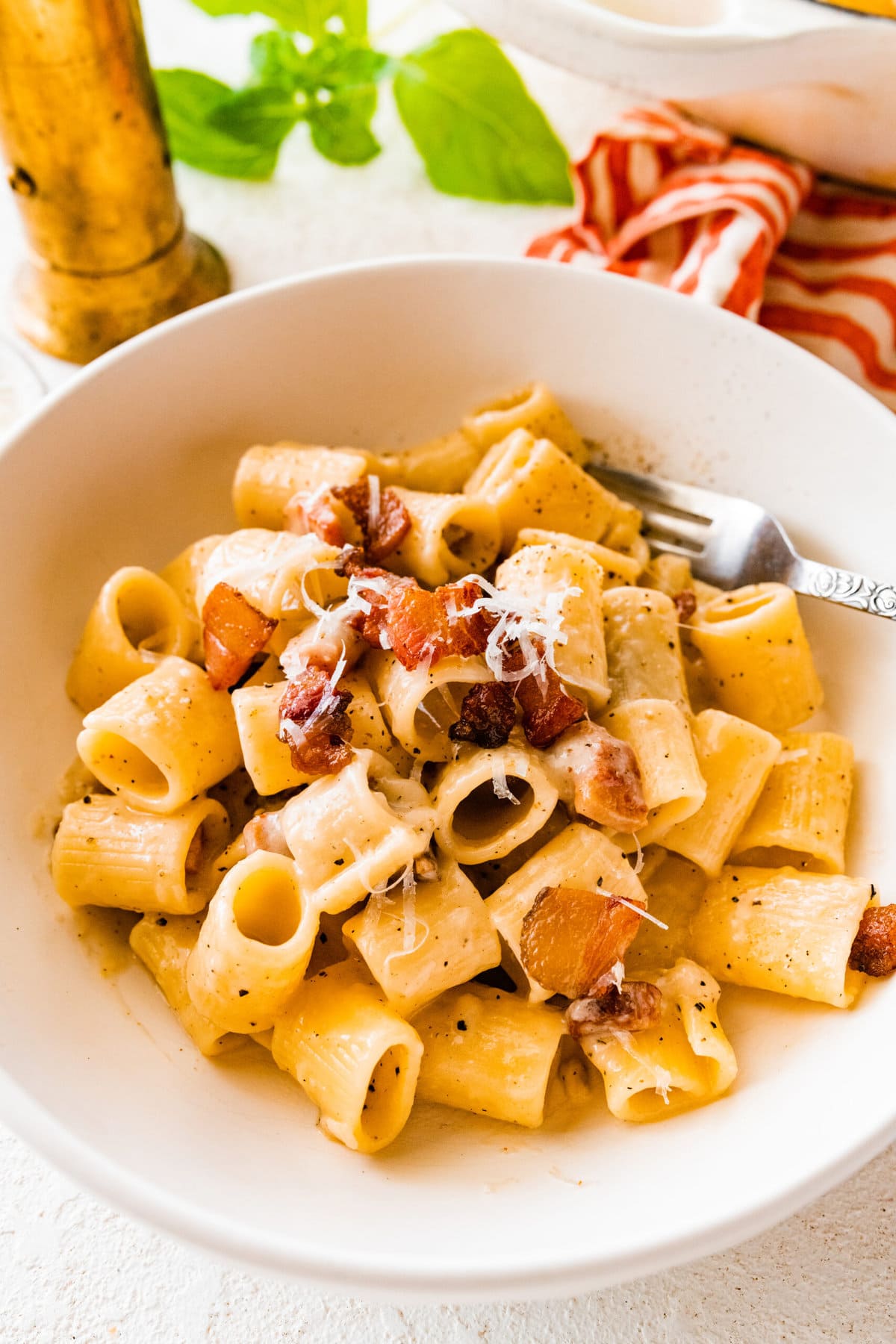Roman Pasta Alla Gricia vs Classic Carbonara + Recipe
Updated May 15, 2025, Published Sep 06, 2023
This post may contain affiliate links. Please read our disclosure policy.
Let’s explore the difference between pasta alla gricia vs. classic carbonara! You’ve probably heard of pasta alla carbonara, but have you heard of its older sister, pasta alla gricia?
With few ingredients in these two classic Roman pasta dishes, the differences can transform the taste of each dish. Join me as we explore the origins, ingredients, and preparations of each one.

Table of Contents
What is Pasta alla Gricia?
Pasta alla gricia is an ancient pasta dish from the Lazio region in central Italy. You can make this dish with pasta, Pecorino cheese, pepper, and guanciale. Another name for Pasta alla gricia is Amatriciana Bianca.
Origins of Pasta alla Gricia
According to food historians, pasta alla gricia was invented around 400 AD. This means you could easily find it in the taverns of Ancient Rome! This dish is so old that some consider it the origin of popular pasta recipes like carbonara and Cacio e Pepe.
Some believe it was first made in the small town of Griciano (hence the name gricia). Then, it grew more popular and spread to Rome and the rest of Lazio. It is probably a dish created by shepherds because the ingredients could be carried around for days without spoiling while they traveled with their grazing flocks.
Griciano is not far geographically from the town of Amatriciana, the place that lends its name to another popular pasta dish, Amatriciana. Pasta alla gricia predates Amatriciana because tomatoes, a main ingredient in the dish, were not used in Italian cooking until the 1800s.
Ingredients In Pasta alla Gricia
Only four simple ingredients come together to make this dish, so they must be all of high quality. And, of course, if you don’t use the right ingredients, you cannot call this delicious dish authentic pasta alla gricia.
The most important of the four main ingredients is the guanciale because its rendered fat gives the dish its flavor. Italians make guanciale by rubbing pork jowl or cheek with salt, pepper, and spices before being hung for at least three weeks to cure. Guanciale has a unique, strong taste and is truly the star of this dish.
Next is the pecorino romano cheese. Pecorino is a hard, salty cheese made from sheep’s milk. In Italian, pecorino is the Italian word for ovine, which comes from or relates to sheep – much like bovine, it comes from or relates to cows.
Romano means that it is a product of Rome, though in today’s world, most of the production of this cheese has moved to Sardinia. Pecorino Romano was a staple of Roman legionnaires during ancient times.

Black pepper is the final ingredient in this simple but flavorful dish. I recommend freshly ground pepper. You can even toast the peppercorns in a pan before grinding or using a mortar and pestle.
Finally, we come to the pasta. Though there are many types of pasta, this dish is usually made with two of the most common pasta shapes: spaghetti or rigatoni. Both (or any pasta you choose) will be a perfect vehicle for the carbonara sauce.
How to make pasta alla gricia
- Add chopped guanciale to a frying pan or large skillet on medium heat with a little olive oil, fry until cooked to your liking. (I prefer crispy guanciale)
- While the guanciale cooks, cook the pasta in salted water until al dente (set aside a few cups of pasta water for the sauce).
- Add about ⅓ cup of the reserved pasta cooking water to the pan with the guanciale. The starchy pasta water will combine with the rendered fat and create a sauce.
- Lower the heat in the pan and add the cooked pasta.
- Stir the sauce until everything is well combined. You can add more water if the sauce is too dry or allow it to reduce if it is too watery.
- Remove the pan from the heat and add half the grated pecorino cheese and a generous amount of black pepper. The residual heat will allow the cheese to melt and form a creamy sauce.
- Serve the pasta immediately and top with the remaining cheese.
You can find my Pasta Alla Gricia recipe here and try it yourself!

Storage and reheating
You can store any leftovers in an airtight container in the fridge for 3-6 days. When reheating, you can use either the stovetop method or the microwave. If you’re using the stove, add the pasta and some broth or water to help rehydrate, then heat slowly while stirring gently. If using the microwave, sprinkle in some water, use a lid with a vent, and reheat for 1-2 minutes, stirring halfway.
What is Carbonara?
Carbonara is a pasta sauce made with eggs, hard cheese (traditionally pecorino but parmesan can be substituted), cured pork, and black pepper. This simple dish has been a staple of Italian cuisine since the 1940s and also has ties to the United States, where it is equally popular.

Origins of Carbonara
Nobody knows exactly when or where pasta alla carbonara was made for the first time, but some clues can lead us to a general conclusion. The names pasta alla carbonara and spaghetti alla carbonara are unrecorded before World War II.
They are also absent from Ada Boni’s La Cucina Romana, a famous cookbook written to save classic Roman dishes from being lost to time.
The name carbonara was first mentioned in a 1950 Italian newspaper as a dish requested by American soldiers after the Allied liberation of Rome. Food blogger Luca Cesari believes that carbonara was born around 1944 after the city was liberated and an excess of American bacon was available.
The name Carbonara and its origins are also highly debated. The name is taken from the Italian word carbonaro, meaning charcoal burner. Some people think it was first made as a hearty meal for Italian charcoal workers. It has also been said that the name is an ode to the Carbonari, an Italian secret society during the early stages of reunification in the early 1800s.
Ingredients in Classic Carbonara Recipe
Much like pasta alla gricia, you can make carbonara with only a few simple ingredients. Most Italians will tell you that there is no cream in authentic carbonara. But, you can use whatever cheese is most available to you.
In Italy, guanciale is usually the meat used in this delicious dish, but it can be difficult to find in the United States, so it is often substituted with pancetta, bacon, or pork belly. Any cured pork will work if there is enough fat to render and emulsify with the starchy water and cheese.

Alla gricia traditionally uses pecorino in the original recipe, but you can substitute it for parmesan. Parmesan cheese has aged longer, so it is harder and drier than pecorino. The taste is more mellow and nutty, whereas pecorino has more of a bite or tang.
The main difference between these two dishes is the addition of eggs in carbonara. Some use only egg yolks, while other recipes use whole eggs. When using eggs in this way, the al dente pasta (or cup of the reserved pasta water) must be warm enough to help combine the eggs with other ingredients but not so hot as to scramble them.
While spaghetti alla carbonara is the most common, you can use any long pasta, short pasta, or other shape you have on hand. What’s most important here is sauce!
How to Make Classic Carbonara
- Place a large pot of salted water over high heat. Bring to a boil. (no more than 2 tablespoons of salt per 500 grams of pasta)
- In a mixing bowl, whisk together the eggs until very well combined and smooth. Add the cheese and mix to incorporate. You should have a thick mass once combined.
- Meanwhile, fry bacon in a pan, on the edge of crispness but not too hard. Remove bacon from pan with a slotted spoon and set aside. Save a couple tablespoons of bacon drippings in the pan. Take the pan or iron skillet off heat and wait to reuse.
- Add pasta to the water and boil until al dente according to your taste and package directions. Reserve ¼ cup of pasta water (in case you need it), then drain pasta.
- Add pasta to the pan with bacon drippings. Then, a little at a time, add the egg mixture, adding some reserved pasta water if needed for added creaminess. After you reach a creamy texture, add the bacon and incorporate into the pasta and sauce. Save a little bacon for garnish.
- Serve immediately, dressing it with some additional grated parmesan cheese and fresh ground pepper.
Check out my recipe for Pasta Carbonara and Roman Sausage Rigatoni. Leave a comment to let me know how it turned out!
Storage and Reheating
You won’t have any leftover portions of these classic Roman pastas (yes, they are that good). But, if you do, you can store them in an airtight container in the fridge for 2-3 days.
You can reheat in the microwave until it reaches the desired temperature. The eggs will cook more in the reheating process, changing the texture and taste.
Pasta alla Gricia vs Classic Carbonara
Now that we’ve gone over each dish’s history, ingredients, and preparations, we can compare their main differences.
The biggest thing that sets these recipes apart is eggs – pasta alla gricia has none! Carbonara includes an egg and cheese mixture, emulsified by the pasta water, to create the silky sauce. Alla gricia uses cheese and the guanciale’s fat that mix together and become a decadent sauce for your pasta.
Another huge difference is the types of cheese. Carbonara uses parmigiano reggiano cheese while alla gricia utilizes pecorino romano. These cheeses are made from different dairy sources (cow milk vs. sheep’s milk) and differ in texture. Parmigiano is aged longer it is harder with a more mellow flavor. Pecorino is softer and has a more intense, tangy flavor.
Similar Recipes for You to Try
Authentic Amatriciana – This classic sauce takes its spiciness from black pepper and its depth of flavor from guanciale. Unline those outlined in this blog post: Amatriciana is a tomato sauce.
Cacio e pepe – translated to “cheese and pepper,” this minimalist cacio e pepe recipe is Italy’s true “mac and cheese
This is a matter left up to the taste of every individual. Some may prefer the tangy bite of pecorino, while others enjoy the fatty, savory egg in carbonara.
There are many different pasta dishes in Italy. But, Rome has 4 popular dishes that everyone should try: cacio e pepe, amatriciana, carbonara, and alla gricia.
The most obvious difference in these dishes is the use of eggs. Carbonara uses eggs while alla gricia does not. Traditionally they use different cheeses as well but it mainly depends on what you have available.
Make sure to leave a ⭐️star rating on the recipe card and comment below if you make the recipe. I love to connect with you through my recipes.
I would love for you to tag me on Instagram @cucinabyelena so I can see your delicious Italian recipes. To get more ideas, follow me on Pinterest.








Informative!